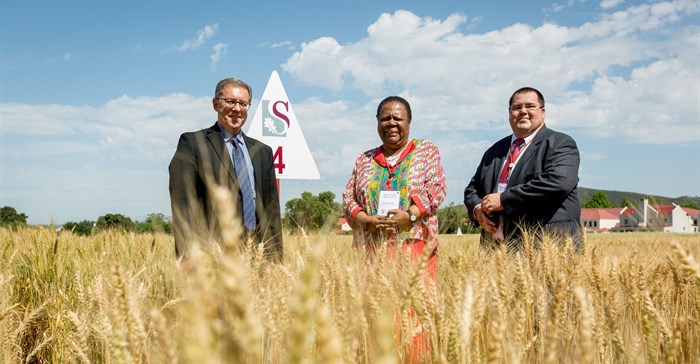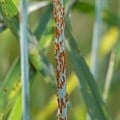The WBP draws on expertise from the private and public sectors with the development of new seed varieties that can withstand South Africa's harsh environmental conditions while boosting yields as its end goal.

From left: Prof Eugene Cloete (vice-rector: research, innovation and postgraduate studies of Stellenbosch University), the Minister of Science and Technology, Naledi Pandor, and Willem Botes (research leader of Stellenbosch University’s Plant Breeding Laboratory). Photo: Stefan Els
According to the minister, the platform fits into the plans of her department to strengthen South Africa’s bio-economy strategy, and to address challenges also faced on the African continent. “New technologies could transform African agriculture, and generate a much-needed improvement in Africa’s food and nutrition security,” she said.
About the Wheat Breeding Platform
According to Dr Marinda Visser, manager: Grain Research and Policy Centre at Grain SA, collaboration with government helps to expand industry-funded research and development activities and complements current breeding research that focuses on crop improvement. “South Africa is already known for the quality of wheat we produce. Our objective with the Wheat Breeding Platform is to also achieve a sustainable increase in wheat productivity and yield,” Visser explained.
The national WBP was established in 2014 and was formalised, expanded and funded to include the SU-PBL’s wheat pre-breeding efforts. Since 2017, it also includes the Agricultural Research Council’s Small Grains (ARC-SG) pre-breeding group. All local breeding programmes have been part of the initiative from the onset, and include the ARC-SG and seed companies Sensako and Pannar as industry partners. Funding comes from the Department of Science and Technology and the Winter Cereal Trust and is facilitated via Grain SA’s Grain Research and Policy Centre.
“The need for an integrated pre-breeding programme came from the industry itself, after a Wheat Forum meeting in 2014 and a series of workshops in subsequent years with role players,” the SU-PBL‘s research leader and plant breeder Willem Botes reflects on the early years of the wheat yield initiative. “Increased yield is what all producers want.”
Funding worth R13m has been allocated through the platform to the SU-PBL over the past three seasons. The funding among others provides for bursaries to postgraduate students in genetics focussing on plant breeding. It has made the acquisition of necessary pieces of equipment possible that enhances the research effort, such as a Wintersteiger experimental harvester and planter, and drones. A Perten 9500 near-infrared spectroscope (NIR) allows its technicians to quickly determine important quality parameters inherent to the germplasm being tested, such as its protein percentage, kernel weight, moisture and flour properties.
The Winter Cereal Building at Welgevallen Experimental Farm was also recently refurbished through funding from Stellenbosch University’s Faculty of AgriSciences. Its growth rooms were fully modernised, while preparation rooms, a germplasm storage facility and a tissue culture facility were added. Bio-safety control measures were also updated. The JH Neethling Glasshouse, which was built through industry funding in 1949, was refurbished to include a seed laboratory to complement the SU-PBL’s existing molecular laboratory.
The SU Plant Breeding Laboratory
The SU-PBL is situated at the Welgevallen Experimental Farm off campus and forms part of the endeavours of the Stellenbosch University Department of Genetics in the Faculty of AgriSciences. The SU-PBL’s efforts as part of the WBP builds on its already established wheat pre-breeding research projects. These among others focus on improving biotic and abiotic stress resistance in wheat.
“Pre-breeding is probably one of the most effective ways to introduce existing or novel genes and traits into breeding programmes,” says SU-PBL research leader and plant breeder Willem Botes.
Since 2003, the SU-PBL has distributed germplasm (the core genetic material inherent in all plants) to all stakeholders participating in South African wheat breeding programmes. Its research efforts aim to select germplasm having traits that assist in improved wheat yield. This includes selecting for premium abiotic traits such as drought resistance, and the ability to withstand extreme temperatures and soils. Biotic qualities being selected include resistance to specific fungi such as wheat rust and fusarium and ones that can withstand the onslaught of certain insects.
To this end, SU-PBL researchers and postgraduate students are sifting through promising germplasm obtained and/or exchanged with both national and international collaborators. The research work also exploring wheat’s wild relatives, such as the indigenous coastal grass Thinopyrum distichum. Developed germplasm is being tested in breeding trails by the SU-PBL. Promising genotypes will eventually be made available to industry partners to expand into seed varieties and sold to wheat producers. Regular engagement with role players, including wheat producers, therefore, form part of the endeavour.
Botes hopes that their efforts as part of the WBP will help develop germplasm that stakeholders such as Pannar, Sensako and the ARC-SG breeding programme can use in their autumn and irrigation breeding programmes. Initial efforts made since the start of the WBP in 2014 have already allowed the SU-PBL to distribute germplasm to these stakeholders in the private and public sector. It forms part of the SU-PBL’s annual germplasm distribution nursery.
One of the seven work packages that are part of the WBP is a collaboration between the SU-PBL and the ARC-SG’s pre-breeding group. It is now also an International Wheat Yield Partnership (IWYP) aligned project – the only one of its kind in South Africa.
“We have high hopes for the expanded Wheat Breeding Platform of which the SU-PBL is part,” says Prof Danie Brink, dean of the SU Faculty of AgriSciences. “No other research group in South Africa annually generates wheat germplasm on a similar scale to the SU-PBL through its pre-breeding efforts.”
“These efforts ensure that Stellenbosch University stays at the forefront of wheat genetic research in South Africa, to the benefit of the local industry,” Prof Brink added.



























